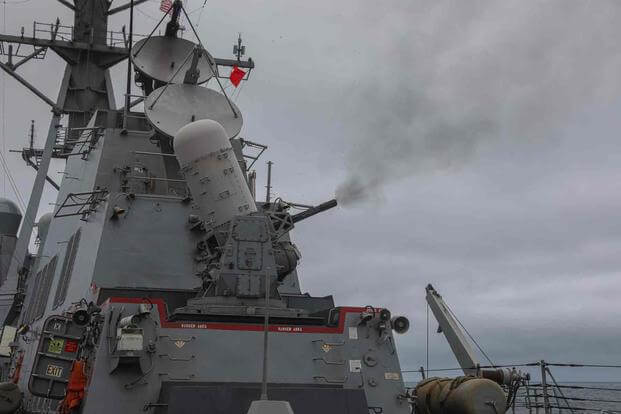As three families prepare to receive the remains of their loved ones -- the three soldiers killed in a drone attack by Iran-backed militants in Jordan over the weekend -- new details are emerging that suggest sailors in the Red Sea are also facing increasing danger amid the regional violence.
U.S. Central Command announced Tuesday that the USS Gravely destroyer shot down an anti-ship cruise missile fired by Iran-backed Houthi rebels in Yemen. The incident initially came across as unremarkable, one of the now more than 40 engagements Navy destroyers have had in the waters off Yemen since October.
However, multiple outlets reported that the Gravely shot down the missile using its Close-In Weapon System, or CIWS -- a gatling gun system that is one of this ship's last lines of defense -- after it came within a mile of the destroyer.
The incident appears to be the closest a Houthi weapon has come to a U.S. warship since the Navy began intercepting the military group's drones and missiles on Oct. 19.
As with nearly every other engagement conducted by destroyers in the area, Navy officials refused to offer any details on the incident to Military.com. As a result, it was unclear just how much danger the crew of the Gravely was in at the time of the shootdown.
Broadly, though, most of the defensive shots by Navy ships have been done with missiles like the Navy's SM-2, which has a range of around 90 miles. It is not clear whether the Gravely was forced to engage the missile at a dramatically closer range because it was not detected in time, missiles were fired but failed to down the threat, or the Houthis are employing a new capability.
If the missile was headed directly for the Gravely -- another detail that remains unclear in official reports -- the crew had just moments to react at a range of a mile.
Leading up to the close call this week, Navy ships have amassed a large number of drone kills and missile intercepts. To date, the destroyers Gravely, Thomas Hudner, Mason, Laboon and Carney have downed more than 50 drones and around 20 missiles launched into the Red Sea.
Officials both in the Navy and the Pentagon have offered only vague, and sometimes conflicting, answers as to whether any of the weapons were targeting U.S. Navy ships directly instead of nearby merchant shipping, which the Houthis have largely claimed to be their primary target.
In talking with reporters in early January, Vice Adm. Brad Cooper, head of the Navy's Central Command, said that there was "no specific information that any U.S. ship has been directly targeted." However, Cooper also presented the Carney with a Combat Action Ribbon, a prestigious combat award that the Navy has rarely bestowed on its ships.
Meanwhile, Gen. Michael Kurilla, head of U.S. Central Command, also flew out to the Carney to present a number of awards to the ship's sailors for their actions in the Oct. 19 incident.
A Navy spokesman said "the team defended the ship and their shipmates from a complex air attack, manifested in the form of multiple hostile air threats traversing the Red Sea, spanning a three-hour interception engagement," despite the fact that at the time of the incident Maj. Gen. Pat Ryder, the Pentagon's top spokesman, told reporters that the missiles were targeting Israel, not the destroyer.
The threats to the Navy come as U.S. troops in the region have been killed and injured in separate attacks by Iran-backed militants.
Three soldiers were killed over the weekend when a drone managed to penetrate the defenses of a small logistics base in Jordan and detonate over a building where soldiers were sleeping. That attack also left more than 40 service members injured. A dignified transfer of the soldiers' remains is planned for Friday.
Bases throughout Iraq and Syria have endured at least 165 attacks since Oct. 17, and they have left at least 80 injured -- a total that doesn't include the deaths and injuries from the attack in Jordan.
In response to the increasing attacks in the Red Sea, the U.S., with some help from the U.K., has begun an open-ended campaign of strikes against the Houthi rebels that is aimed at reducing their ability to launch missiles.
The campaign opened with a massive retaliatory strike on more than 60 targets in Yemen on Jan. 11. Another, similar large strike followed 11 days later.
Since those strikes, U.S. warships have also begun conducting preemptive strikes on Houthi positions. The latest one, conducted Wednesday, took out a drone ground control station and 10 drones.
Related: Army Posthumously Promotes 2 Georgia Soldiers Who Were Killed by Iran Militia Drone Attack in Jordan












